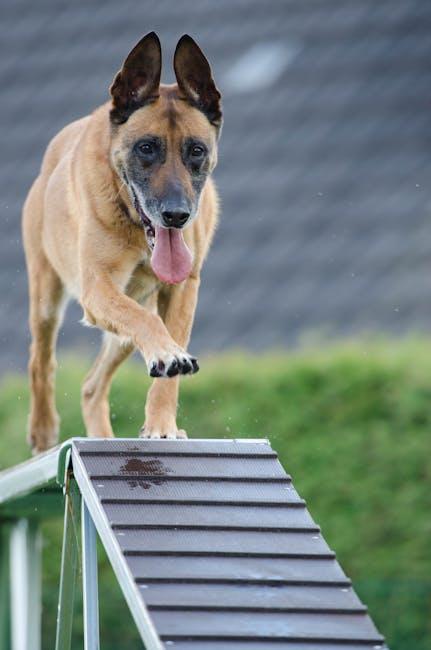In the world of dog training, patience is not merely a virtue; it is an essential cornerstone that fosters understanding and growth between you and your canine companion. As you embark on this rewarding journey, it’s important to recognize that training is not just about teaching commands or correcting behavior—it’s about building a lasting bond grounded in trust and mutual respect. This article will explore the pivotal role patience plays in effective dog training, offering insights and practical tips to help you nurture a positive and harmonious relationship with your furry friend. Whether you’re a seasoned trainer or a first-time dog owner, embracing patience will open the door to a more fulfilling and successful training experience.
Understanding Canine Psychology for Effective Training
Training a dog is not just about teaching commands; it’s about fostering a relationship built on trust and understanding. One of the most crucial elements in this process is patience. When you approach training with patience, you allow your dog the time to understand what is being asked of them, creating an environment where they can learn at their own pace. This understanding is especially important when working with breeds that are known for their independent nature. By exercising patience, you communicate to your dog that mistakes are part of the learning process, not something to be feared.
- Consistency: Consistent cues and reactions help your dog to associate specific actions with specific outcomes.
- Repetition: Repeating exercises helps reinforce learning, turning new behaviors into habits.
- Positive Reinforcement: Rewarding desired behavior encourages your dog to repeat it, strengthening the bond between you.
Remember, each dog is unique, and their journey to learning will vary. By prioritizing patience, you not only enhance your dog’s ability to learn but also nurture a more profound and rewarding connection.

Building Trust and Bonding Through Patience
Patience is the cornerstone of any successful dog training endeavor, serving as the bridge between understanding and empathy. When we approach training with patience, we cultivate an environment where trust can flourish. Dogs, much like humans, thrive in settings where they feel secure and understood. By exercising patience, we allow them the time they need to comprehend new commands and behaviors, reducing anxiety and fostering a stronger connection. This patient approach leads to more profound learning and a deeper bond, as dogs begin to associate training sessions with positive experiences rather than stress.
- Consistency: Regular and consistent training helps reinforce desired behaviors, but it’s patience that keeps us committed to the process.
- Understanding: Recognizing that every dog learns at their own pace ensures that we tailor our methods to fit their unique needs.
- Positive Reinforcement: Rewarding small victories with treats or praise nurtures a trusting relationship, encouraging your dog to engage willingly.
By integrating patience into your training routine, you not only enhance your dog’s learning experience but also lay the groundwork for a lifelong bond built on trust and mutual respect.

Step-by-Step Techniques to Cultivate Patience
Embarking on the journey of dog training requires a toolkit enriched with a variety of techniques to nurture patience. A calm demeanor and understanding mindset can transform the training process into a rewarding experience for both you and your furry friend. Here are some strategies to help you cultivate patience:
- Mindful Breathing: Before each training session, take a few deep breaths to center yourself. This simple act can ease tension and help you approach training with a calm and open mind.
- Set Realistic Expectations: Understand that every dog learns at its own pace. Celebrate small victories and progress, no matter how minor they may seem.
- Break Tasks into Small Steps: Simplify tasks into manageable segments. This not only helps your dog grasp new commands more easily but also keeps frustration at bay for both parties.
- Practice Consistency: Consistency is key in training. Regular sessions and repeated commands reinforce learning and build trust between you and your pet.
- Embrace the Pause: If you find frustration creeping in, take a break. A short pause allows you to regroup and return to training with renewed patience and enthusiasm.
By integrating these techniques into your training routine, you’ll foster a harmonious and effective learning environment that respects the unique journey of your canine companion.
Practical Tips for Maintaining Consistency and Calmness
In the journey of dog training, maintaining a steady pace of progress while fostering a serene environment is key. Here are some practical tips to help you achieve this balance:
- Set Realistic Goals: Break down the training process into manageable steps. Focus on one command or behavior at a time to avoid overwhelming your furry friend.
- Consistent Routines: Dogs thrive on routine. Establish a regular training schedule that fits seamlessly into your daily life, ensuring both you and your pet know what to expect.
- Patience as a Virtue: Remember, patience is not just about waiting; it’s about keeping a positive mindset while doing so. Celebrate small victories and understand that setbacks are part of the process.
- Calm Energy: Dogs are sensitive to your emotional state. Maintain a calm demeanor during training sessions to help your dog feel secure and focused.
By incorporating these strategies, you’ll create a nurturing training environment that emphasizes patience, ultimately leading to a more rewarding experience for both you and your canine companion.

